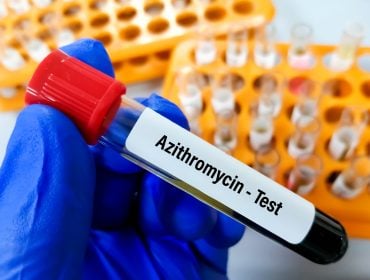Trichomoniasis in Men
Trichomoniasis isn’t an STD you often hear about. It’s not flashy or in your face, it’s not portrayed on TV, and there aren’t entire organizations dedicated to help stop the spread of it. But did you know that it’s the most prevalent non-viral STD in the world? Astonishing, right? And what’s even more astonishing is that even though it’s is so widespread, there is so little information about trichomoniasis in men.
Trichomoniasis (pronounced trik-uh-muh-nahy-uh-sis), or “trich” for short, is caused by a protozoan called Trichomonas Vaginalis. If you’re unsure about what protozoa are, don’t Google it in a new tab; we’ll be discussing it soon! But before we do, it’s good to note that trich isn’t an STD that most women think about, and unfortunately, men tend to think about trich even less. In fact, when men first hear of this STD, many may assume that with a name like Trichomonas VAGinalis, it’s not possible for them to get it. This is a huge mistake. Not only can men get trichomoniasis, but if left untreated, it can lead to serious complications. That’s why it’s extremely important for men to understand what trich is and how they can contract it, along with its symptoms, diagnosis, treatment, and prevention.
What is Trich in men and How is it Different from other STDs?
 As we stated before, Trichomonas Vaginalis is the protozoan that causes trich. This makes trich a little different from other STDs, which aren’t caused by protozoa, but rather viruses and bacteria. Now it may have been a while since you took a biology class, so let’s break down the difference:
As we stated before, Trichomonas Vaginalis is the protozoan that causes trich. This makes trich a little different from other STDs, which aren’t caused by protozoa, but rather viruses and bacteria. Now it may have been a while since you took a biology class, so let’s break down the difference:
Viruses are the smallest of the three germs. A virus is not a living thing; in fact, it’s kind of the opposite. Viruses replicate inside of living cells of other organisms. Once they’re finished replicating, they destroy the cells they’ve used. Additionally, viruses can’t survive outside of their host’s body for very long.
Viral STDs include herpes, HIV, and hepatitis.
Bacteria, on the other hand, are living things. They are single-celled, prokaryotic microorganisms. “Prokaryotic” means that they don’t have a “nucleus,” also known as the brain of the cell. Bacteria have a simple structure, and their DNA just kind of floats around in a tangled mass.
Bacterial STDs include chlamydia, gonorrhea, and syphilis.
Protozoa are like bacteria because they’re also living things. But unlike bacteria, these single-celled microorganisms are eukaryotic. “Eukaryotic” means that they have a nucleus, and their overall cell structure is more advanced.
Trichomoniasis is the only STD that is caused by protozoa.
Now that we understand what trich is and how it’s different than other STDs, let’s dive into how this smart little organism can infiltrate your body.
Trich in men

In women, trich tends to live in the vagina, while in men, trich typically inhabits the urethra. FYI, the urethra is the canal that connects the bladder and the ejaculatory ducts to the penis. Since these two trich hotbeds come into direct contact with one another during male/female sexy time, trich spreads almost seamlessly. At the same time, this makes it very difficult for men who have sex with men (MSM) to contract trichomoniasis as it doesn’t live in the rectum, mouth, or hand.
Trich passes when protozoa come into contact with suitable living conditions. And while we wish we could say that the only suitable living conditions are in human reproductive organs, that’s not the case. According to the Indian Journal of Sexually Transmitted Diseases and AIDS, Trichomonas Vaginalis can transfer onto nonliving surfaces such as towels. If these infected surfaces come into contact with a non-infected person, trich can transfer to that person. Nonliving surfaces that are vectors for transmitting diseases are called “fomites.”
Because of fomites, trich is an STD that can be transmitted nonsexually. It’s important to bear this in mind; realize that even if you’re a virgin or in a monogamous relationship, you can still get trich! Trich can be obtained from public laundromats, gym towels, or even trying on swimsuits. Though it is uncommon, these tricky protozoa can contaminate you even when you think you’re not at risk.
So because you can get trich even when you don’t think you’ve put yourself at risk, it’s important to be able to recognize the signs and symptoms, in case you begin exhibiting them.
Trichomoniasis Symptoms In Men

Since trich lives in men’s urethras, it tends to exhibit symptoms there as well. Symptoms may include painful urination and ejaculation, itching and burning inside the penis, slight discharge from the penis, and/or slight discomfort in the penis area. Basically, if you’re experiencing any discomfort related to penile functions, you should get tested for trich.
While these are the symptoms that can present themselves, it’s best to note that most of the time, there are no symptoms. In fact, according to the CDC, only 30 percent of people with trich report any symptoms at all. That means 70 percent of the time, people do not experience any symptoms or the symptoms are so mild that they go unnoticed. That’s right; most of the symptoms are seen as mild annoyances rather than big, scary STD symptoms. This allows the disease to go undetected and continue to spread without the host even knowing it.
Trichomoniasis symptoms in men can include:
- Discharge from the penis: This may be clear or yellowish in color and have a foul odor.
- Irritation or itching inside the penis: This can cause discomfort or burning during urination.
- Pain or discomfort during ejaculation: This can also be accompanied by a burning sensation.
- Redness or swelling of the penis: The head of the penis may also be sore or inflamed.
- Pain or discomfort in the lower abdomen: This can occur in some men.
It is important to note that not all men with trichomoniasis will have symptoms, and the symptoms can vary in severity.
What are the Complications of Trichomoniasis for Men?

Trich can sneak under the radar and go undetected for years, which can cause pretty dire complications in men. The urethra plays a vital role in both the reproductive and urinary systems, and if trich is left to fester in there, both systems suffer the consequences.
Urinary System Complications
The following can be the results of trich’s impact on the urinary system:
- Urethritis (swelling of the urethra)
- Chronic UTIs (urinary tract infections)
- Chronic Bladder Infections
Reproductive System Complications for Trich in Men:
The following can result from trich’s impact on the reproductive system:
- Prostatitis (swelling of the prostate gland)
- Epididymitis (swelling of the “epididymis,” also known as the tube that houses and carries sperm)
- Orchitis (swelling of one or both testicles),
- Susceptibility to HIV
- Prostate Cancer
- Infertility
When treating these disorders, it’s easy to see them as diseases that just manifested on their own, when in fact, they were caused by trichomoniasis.
Treating prostatitis or UTI will ease the symptom, but it won’t remedy the cause: trich. So with all these disastrous complications caused by a single-celled microorganism, it must be pretty hard to diagnose, right? Wrong.
Diagnosing for Trich in Men:

Trich can be diagnosed in men via two routes: a urine sample or a urethral swab.
Urine Sample
When testing urine, it’s best to get the “first-void urine” or the “first-catch urine.” Both of these refer to the first urine of the day. It’s best to get the first urine because as we go through the day, we drink more fluids. More fluids mean the urine becomes more diluted. With diluted urine, the concentration of protozoa will decrease in any given sample.
Urethral Swab
To get a urethral swab, a cotton swab is inserted into the urethra (ouch!), and the sample is cultivated off of the swab. In order to get a good sample, it’s recommended that you don’t urinate for at least two hours before the test.
Both the urine sample and urethral swab are examined using a special dish called a “culture,” where the doctor will try to grow the protozoa in the lab.
While it’s easy to diagnose trich, it’s also easy to miss. Since the culture requires at least 10^3/ml of living protozoa, you may show up negative even if you do have the STI. This tends to occur when the sample is diluted (from not using first-void urine or from urinating too close to the time you’ll be tested). And even if the test shows a false negative, it’s still possible to spread the infection. That’s why it’s important to seek treatment if your partner tests positive for trich, even if you test negative.
Trichomoniasis Treatment and Prevention

Trich is one of the simplest STDs to cure. The most common way to get rid of trich is through a single dose of an antibiotic. That’s right; one pill and boom! All trich is gone! The antibiotics prescribed are usually metronidazole (flagyl) or tinidazole. Both antibiotics are given in a single 2-gram oral dose, and they can be taken immediately. It’s good to note that these medications must be prescribed and cannot be bought over the counter.
As far as prevention goes, the best way to prevent yourself from catching trich is to wear a condom. Trich can’t infect you if it doesn’t come into contact with your urethra! So wear a condom every time you engage in vaginal intercourse to protect yourself.
Secure and Confidential
STD testing services
The fastest results possbile - available in 1 to 2 days
While a condom will protect you from catching it directly from a partner, there’s still the issue of catching it from fomites. And it’s not feasible for us to suggest you wear a condom every time you use a towel from the gym (although, that would be funny, to say the least). So we say that the best way to protect yourself is to be aware that trich could be lurking in any clothing, linen, or towel recently used by someone else. Make sure that the item you’re using came from a trusted source, and that the item was cleaned.
Finally, help stop the spread of trichomoniasis by getting tested at the first sign of trich. It’s the most underdiagnosed STD, and oftentimes, this leads to reinfecting partners. In fact, according to a study done by the CDC, 1 out of 5 people who get treated for trichomoniasis become reinfected within 3 months of treatment. This is most likely due to partners not getting tested, diagnosed, or treated.
Don’t get Tricked by Trich!

The fact that trichomoniasis isn’t talked about as much as other STDs makes it even easier for it to slide in unannounced and make itself at home in your urethra. But now that you know all about this sneaky parasite, you won’t get tricked by trich! Remember that men can get trich, its symptoms are often mild, and if left undiagnosed, it can lead to drastic consequences. So recognize the risk factors and get tested at the first sign that something’s off! Don’t let trich trick you too! We hope this gives some clarity to Trichomoniasis in Men. Contact us for any questions you may have.
Worried about something living in your urethra? Add a trich test to your order at checkout!
Medically Reviewed by J. Frank Martin JR., MD on October 9, 2023
Secure and Confidential
STD testing services
The fastest results possbile - available in 1 to 2 days

Tagged
Categorized As
Author: STD Check Editorial Team
At STDCheck.com, we go to great lengths to ensure quality content. We’re using our own collection of data. It is not bought or made up for “click-bait” purposes. We don’t entice traffic with cheesy graphics or raunchy headlines. Our information is to promote STD testing, educate people, let go of social stigmas, and bring awareness. We also provide a completely confidential atmosphere through private testing. When we produce an article, it is fact-based. We check it with medical advisors that approve it. Our staff consists of doctors and other medical professionals who peer review the content we make available on STDCheck.com. From all over the world, we have sourced the best and the brightest content developers, including medical professionals, marketing engineers, data scientists, content specialists, and media relations.




